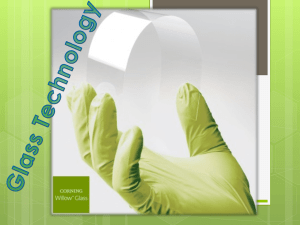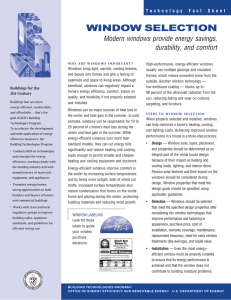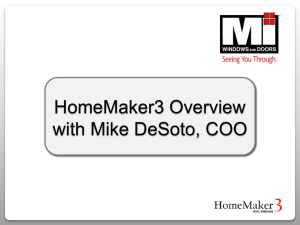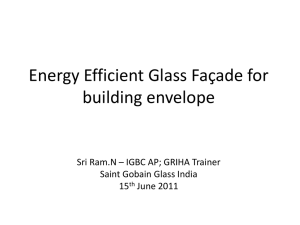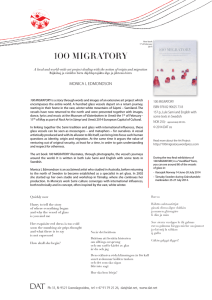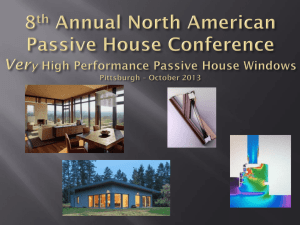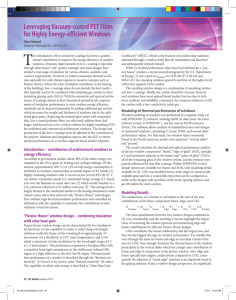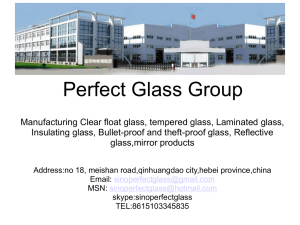Guardian Industries
advertisement
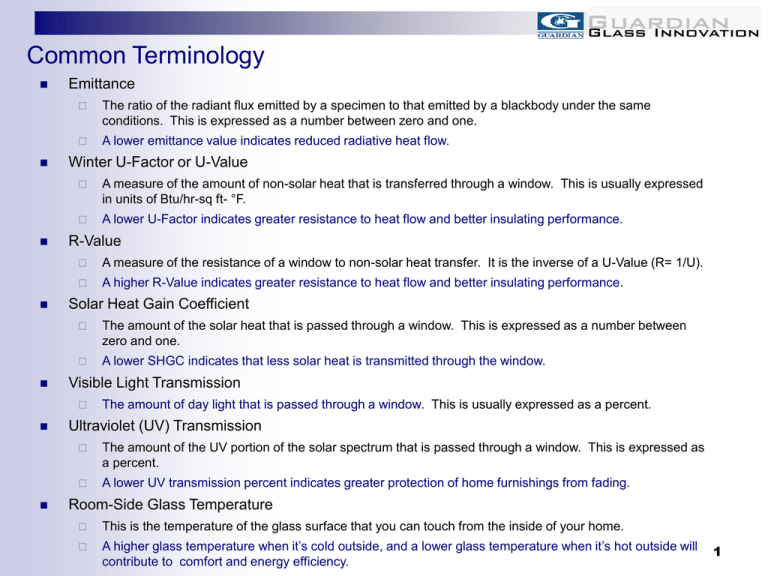
Common Terminology Emittance The ratio of the radiant flux emitted by a specimen to that emitted by a blackbody under the same conditions. This is expressed as a number between zero and one. A lower emittance value indicates reduced radiative heat flow. Winter U-Factor or U-Value A measure of the amount of non-solar heat that is transferred through a window. This is usually expressed in units of Btu/hr-sq ft- °F. A lower U-Factor indicates greater resistance to heat flow and better insulating performance. R-Value A measure of the resistance of a window to non-solar heat transfer. It is the inverse of a U-Value (R= 1/U). A higher R-Value indicates greater resistance to heat flow and better insulating performance. Solar Heat Gain Coefficient The amount of the solar heat that is passed through a window. This is expressed as a number between zero and one. A lower SHGC indicates that less solar heat is transmitted through the window. Visible Light Transmission The amount of day light that is passed through a window. This is usually expressed as a percent. Ultraviolet (UV) Transmission The amount of the UV portion of the solar spectrum that is passed through a window. This is expressed as a percent. A lower UV transmission percent indicates greater protection of home furnishings from fading. Room-Side Glass Temperature This is the temperature of the glass surface that you can touch from the inside of your home. A higher glass temperature when it’s cold outside, and a lower glass temperature when it’s hot outside will contribute to comfort and energy efficiency. 1 Heat Moves From Where It’s Hot, To where It’s Not Radiation losses occur through the window glass and represent about 66% of total heat loss in a standard window Low-E glass dramatically reduces radiation heat loss Conduction losses in windows occur primarily through the edges of the glazing and through the sash and frames Changes in sash and frame construction, use of “warm edge” spacer material, and the use of inert gasses have reduced conductive heat loss Convection losses occur due to air movement caused by temperature fluctuation Air Leakage is a significant contributor to heat losses Window design and installation technique must be carefully managed to minimize air leakage 2 Thermal Imaging Demonstrates Advances In Window Glass Technology Double Glaze Std. Clear Glass Metal Spacer Double Glaze Std. Clear Glass Foam Spacer Double Glaze Low-E Glass Foam Spacer ↑ ↑ ↑ ↑ ↑ ↑ ↑ ↑ 21 28 35 41 48 55 62 68 °F 3 Low-E Coatings Are Comprised Of Carefully Tuned Layers, Providing Thermal, Solar and Optical Properties. Ozone Layer (20 – 25 KM Above Ground Level) Gamma Rays X-Rays UVC 100 – 380nm 380 – 760nm 760 – 1,000nm Ultraviolet Rays Visible Rays Infrared Rays 280 – 320nm 320 – 380nm UVB UVA Si3N4 Scratch Resistance Sno2 Optical Filter NiCrOx Adhesive Barrier Ag ZnO Thermal & Solar Performance Performance Enhancer Sno2 Optical Filter NiCrOx Ag Adhesive Barrier Thermal & Solar Performance ZnO Performance Enhancer TiO2 Si3N4 Optical Enhancer Barrier Layer Glass Glass 4 Low-E Coatings Have Changed Glass From An Energy Liability To An Energy Asset Standard glass has a high emissivity Furnace-generated heat moves freely from in to out. Solar heat moves freely from out to in. Low-E coated glass has a low emissivity Furnace-generated heat is retained. Solar heat is rejected. Low-E coatings act like a filter to manage heat transfer Some energy wavelengths pass through, while others are rejected Furnace energy (long wave radiation) Solar energy (short wave radiation) 5 Low-E Glass Keeps The Heat Where You Want It, Regardless Of The Climate Or Season Retains Furnace Heat, Keeping You Warm When It’s Cold Outside Escaping long wave energy (furnace energy) leads to discomfort associated with heat loss Better insulating performance (lower U-factor) minimizes home heat loss when outdoor temperatures are lower than desired indoor temperatures U-Factor 6 Low-E Glass Keeps The Heat Where You Want It, Regardless Of The Climate Or Season Rejects Excessive Solar Heat, Keeping You Cool When It’s Hot Outside Unwanted short wave energy (solar energy) leads to discomfort associated with excessive heat gain Low solar gain (lower SHGC) low-E eliminates overheating when outdoor temperatures are higher than desired indoor temperatures SHGC 7 Low-E Glass Transmits Natural Daylight And Reduces Damaging UV Radiation Transmits Natural Daylight, Brightening Your Home And Your Mood Visible Light Reduces Damaging UV Rays, Protecting Home Furnishings UV 8 The Evolution of Window Glass as Positively Impacted Comfort, Energy Efficiency, and the Life-Span of Typical Home Furnishings Glass Package Visible Light Ultraviolet Light SHGC Room-Side Glass Temperature U-Factor (Daylight) (Fading) (Solar Management) (Summer / Winter) (Thermal Management) air argon Single Pane, Clear Glass 90% 72% 0.87 90˚ F 15˚ F 1.11 n/a Double Pane,Clear Glass 82% 57% 0.77 90˚ F 44˚ F 0.48 0.46 Double Pane, Low-E Glass 70% 29% 0.36 83˚ F 56˚ F 0.29 0.24 Heat loss has been reduced Heat gain has been reduced Day light has been maintained Fading and deterioration have been reduced 9
